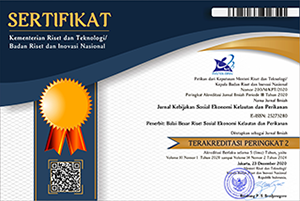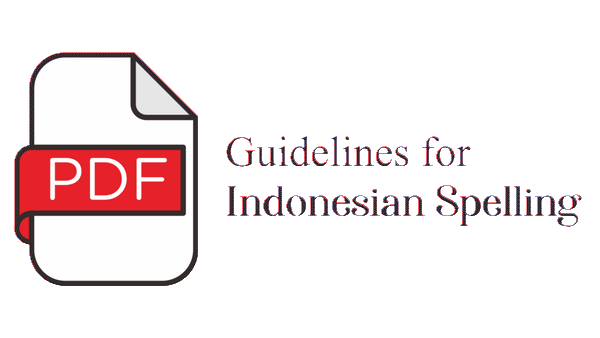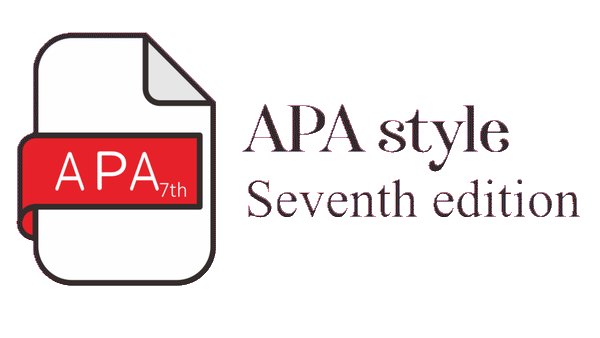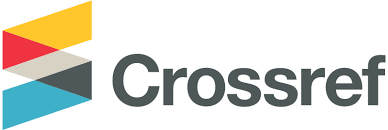Penguatan Kelembagaan Korporasi Pembudidaya Tambak Udang dan Ikan di Kawasan Pertambakan di Indonesia
Abstract
Penelitian ini dilatarbelakangi oleh lambatnya pembentukan korporasi pada kawasan pertambakan di Indonesia. Tujuan penelitian adalah: (i) melakukan pemetaan keragaman penguasaan luasan tambak di berbagai pulau dan provinsi dalam kaitannya dengan pengembangan korporasi; (ii) mengidentifikasi peran komponen kelembagaan korporasi pertambakan; (iii) menyusun strategi pengembangan kelembagaan korporasi tambak di Indonesia, yang dituangkan pada model generic korporasi petambak untuk kawasan tambak dengan luas minimal 100 hektar. Pendekatan metodologis yang diterapkan dalam penelitian ini adalah pendekatan kuantitatif dengan menggunakan analisis
statistik deskriptif. Data Sensus Pertanian 2013 (jumlah sampel 138.865 responden) dan data hasil survey
tahun 2023 di Kabupaten Brebes dan Kabupaten Indramayu (100 responden) digunakan untuk menjawab hipotesis penelitian ini. Hasil penelitian menunjukkan korporasi pembudidaya tambak dapat dibentuk pada beberapa lokasi di provinsi tertentu, dengan lima komponen korporasi walaupun belum berperan. Model generik korporasi pembudidaya tambak tersebut, menjadi basis untuk membangun bisnis on farm–off farm korporasi dengan memfungsikan lima komponen korporasi pembudidaya tambak melalui prinsip konsolidasi, kolaborasi dan integrasi. Implikasi kebijakan dari hasil penelitian ini adalah relevansi pemahaman bahwa: (i) identifikasi dan pemetaan sebaran petambak dan luas kawasan pertambakan harus ditempatkan sebagai langkah paling awal dalam pengembangan korporasi pada sektor kelautan dan perikanan, (ii) petambak mutlak harus diorganisasikan dalam Gapokkan sehingga dapat mengatasi masalah produksi dan pasar, dan (iii) komponen-komponen korporasi dari model generik merupakan hal yang vital di dalam upaya membangun korporasi pada satu kawasan pertambakan.
Tittle: Strengthtening Institution of Shrimp and Fish Farmer Corporates in the Brackish Water Area in Indonesia
This research is motivated by the slow formation of corporations in brackish water areas in Indonesia. The aims of the study were: (i) Mapping the diversity of pond control over various islands and provinces about corporate development; (ii) identifying the role of the institutional components of the aquaculture corporation; (iii) developing a strategy for developing pond corporation institutions in Indonesia, on the generic model of corporation farmers for pond areas with a minimum area of 100 hectares. The methodology of the study is a quantitative approach using descriptive statistical analysis. The answer research hypothesis used Agricultural Census data for 2013 (sample of 138,865 respondents) and survey data for 2023 in Brebes and Indramayu Regencies (100 respondents). The study highlights that pond cultivator corporations can be formed in several locations in certain provinces, with five corporate components, even though they have not played a role yet. The generic model of the pond cultivator corporation is the basis for building a corporate on farm – off farm business by functioning the five components of the pond cultivator corporation through the principles of consolidation, collaboration and integration. The policy implications of the results of this study are the relevance of the understanding that: (i) identification and mapping of the distribution of farmers and the area of brackish water must be placed as the earliest step in corporate development in the Maritime and Fisheries Sector, (ii) absolute farmers must be organized into Gapokkan so that they can overcome production and market issues, and (iii) the corporate components of the generic model are vital in the effort to build a corporation in a brackish water area.
Keywords
Full Text:
PDFReferences
Bahri S., Indra., & Muyassir. (2014). Kualitas Lahan Tambak dan Sosial Ekonomi Pada Budidaya Udang dan Ikan di Kecamatan Seunuddon Kabupaten Aceh Utara. Jurnal Manajemen Sumberdaya Lahan. Volume 3, Nomor 1, April 2014: hal. 412-420.
Bernard, T. & D.J. Spielman. (2009). Reaching the rural poor through rural producer organizations? A study of agricultural marketing cooperatives in Ethiopia. Food Policy, 34(1) 60-69. https:// doi.org/10.1016/j.foodpol.200808001.
Biro Perencanaan. (2022). Korporasi Nelayan Cilacap dan Pembudidaya Ikan OKU Timur. Kementerian Kelautan dan Perikanan.
_____ (2023). Rencana Pembentukan Korporasi Nelayan dan Pembudidaya Ikan. Kementerian Kelautan dan Perikanan.
Booth, A. & P. McCawley. (1981). The Indonesian Economy During The Soeharto Era. Kuala Lumpur: Oxford University Press.
Endro, G. (2016). Tinjauan Filosofis Praktik Gotong Royong. Respons: Jurnal Etika Sosial, 21(01), 89-111.
Francesconi, G.N., & N. Heerink. (2011). Ethiopian agricultural cooperatives in an era of global commodity exchange: Does organisational form matter?. Journal of African Economies, 20(1), 153-177. https://doi.org/10.1093/jae/ejq036.
Gompers, P., & J. Lerne. (2001). The Venture Capital Revolution. Journal of Economic Perspectives. Vol (15) 2: 145–168.
Global news. (2021). Korporasi Petani Dan Nelayan Melalui Koperasi Moderen. https://globalnews.id/korporasi-petani-dan-nelayan-melalui-koperasi-moderen/ diakses 26 Mei 2023.
Hansen G B., E.K. Coontz & M. Audrey. (2011). Steps to Starting a Worker Co-op. Northwest Cooperative Federation and the Center for Cooperatives. University of California. http://www.us-worker.coop/howtos.
Halal, W.E. (2000). Corporate community: Strategy & Leadership, JCC: 28(2), 10–16. George Washington University, USA. doi:10.1108/10878570010341582.
Holloway, G., C. Nicholson, C. Delgado, S. Staal & S. Ehui. (2000). Agroindustrialization through institutional innovation: Transaction costs, cooperatives and milk-market development in the East-African highlands. Agricultural Economics, 23(3), 279-288 https://doi.org/10.1016/S0169-5150(00)00089-X.
Kaganzi, E., S. Ferris, J. Barham, A. Abenakyo, P. Sanginga & J. Njuki. (2009). Sustaining linkages to high value markets through collective action in Uganda. Food Policy, 34(1), 23-30. https://doi.org/10.1016/j.foodpol.200810.004.
Kemenko Perekonomian. (2022). Tingkatkan Entrepreneur Skill dan Dorong Skala.
Ekonomi yang Efisien, Pemerintah Kembangkan Korporasi Petani dan Nelayan.
https://www.ekon.go.id/publikasi/detail/4417/tingkatkan-entrepreneur-skill-dan-dorong-skala-ekonomi-yang-efisien-pemerintah-kembangkan-korporasi-petani-dan-nelayan. Diakses: 26 Mei 2023.
Koppenberg. M., S. Hirsch. (2021).Output market power and firm characteristics in dairyprocessing: Evidence from three EU countries. J Agric Econ. 2021;00:1–28. DOI: 10.1111/1477-9552.12460.
Koch, J.A., & S. Michael. (2015). Crowdfunding Success Factors: The Characteristics of Successfully Funded Projects on Crowdfunding Platforms. Twenty-Third European Conference on Information Systems (ECIS), Münster, Germany, 2015.
KSP. (2022). Presiden Ingin Petani – Nelayan Sejahtera Lewat Korporasi. https://koransn.com/ksp-presiden-ingin-petani-nelayan-sejahtera-lewat-program-korporasi/. Diakses 26 Mei 2023.
Lichtkoppler Frank, R., “Factors to Consider in Establishing a Successful Aquaculture Business in the North Central Region” (1993). NCRAC Technical Bulletins. 13. http://lib.dr.iastate.edu/ncrac_techbulletins/13. United States Department of Agriculture Grant #89-38500-4319.
Lerner, J & J. Tag. (2013). Institutions and venture capital. Industrial and Corporate Change, Vol (22)1: 153-182. doi:10.1093/icc/dts050.
Markelova, H., Meinzen-Dick, R., J. Hellin & S. Dohrn. (2009). Collective action for smallholder market access. Food Policy, 34(1), 1-7. https:// doi.org/10.1016/j. foodpol.200810.001.
Masyitoh, K. (2017). Lelang Bandeng Tradisional Di Kabupaten Sidoarjo Tahun 1969-2006. AVATARA, e-Journal Pendidikan Sejarah Volume 5, No. 2, Juli 2017.
Nugroho, T, (2021). Korporasi Nelayan. Korporasi Nelayan - Kompas.id. /baca/opini/2021/10/22/korporasi-nelayan. Diakses 26 Mei 2023.
Nicholas, J. (1999). Introduction to Descriptive Statistics. Mathematics Learning Centre University of Sydney NSW.
Okello, J.J., C. Narrod & D. Roy. (2007). Food safety requirements in African green bean exports and their impact on small farmers. Washington, D.C: International Food Policy Research Institute. https://citeseerx.ist.psu.edu/viewdoc/download? doi=10.1.1.139.555& rep=rep1&type=pdf.
Peraturan Presiden Republik Indonesia Nomor 18 Tahun 2020, tentang Rencana Pembangunan Jangka Menengah Nasional 2020-2024. Lembaran Negara Republik Indonesia Tahun 2020
Nomor 10.
Purwanti, A.D. (2017). Perkembangan Budi Daya Ikan Bandeng Di Gresik Tahun 1982-1989. AVATARA, e-Journal Pendidikan Sejarah. Volume 5, No. 2, Juli 2017.
Puspita, M.C & A.F. Sunartomo. (2019). Peran Kelompok Pembudidaya Ikan (Pokdakan) Aci Bahari Dalam Pembudidayaan Ikan Bandeng Di Desa Pesisir Kecamatan Gending Kabupaten Probolinggo. JSEP Vol 12 No 2 Juli 2019.
Rabanal H.R. (1988). History of Aquaculture. ASEAN/SF/88/ Tech.7. ASEAN/UNDP/FAO Regional Small-Scale Coastal Fisheries Development Project, Manila, Philippines
Reardon, T., C.B. Barrett, J.A. Berdegu´e & J.F. Swinnen. (2009). Agrifood industry transformation and small farmers in developing countries. World Development, 37 (11), 1717–1727. https://doi. org/10.1016/j.worlddev.2007.09.009.
Rimmer M.A., K. Sugama., D. Rakhmawati., R. Rofiq & H.H. Richard. (2013). A review and SWOT analysis of aquaculture development in Indonesia. Reviews in Aquaculture (2013) 5, 1-25. doi: 10.1111/raq.12017.
Rivera, V.S., P.M. Cordero, D.C. Rojas & B. O’Riordan. (2017). Institutions and collective action in a Costa Rican small-scale fisheries cooperative: thecase of CoopeTárcoles R.L. Maritime Studies, 16(1), 1-19. https://doi: 10.1186/ s40152-017-0077-1.
Rossi, A & S. Vismar. (2018). What do crowdfunding platforms do? A comparison between investment-based platforms in Europe. Eurasian Bus Rev (2018) 8:93-118. https://doi.org/10.1007/s40821-017-0092-6.
Roy, D. & A. Thorat. (2008). Success in high value horticultural export markets for the small farmers: The case of Mahagrapes in India. World Development, 36(10), 1874-1890. https:// doi.org/10.1016/j.worlddev.2007.09.009.
Samian, M., H. Saadi., M. Asadi., K. Mirzaei., E. Ansari., E. Ahmadihagh., A. Soleymani. (2015). The role of fishing cooperatives on social-Economic and cultural development of rural areas of Bord Khun city of Bushehr, Iran. Journal of the Saudi Society of Agricultural Sciences. pp: 178-183. http://dx.doi.org/ 10.1016/j.jssas.2015.06.001
Saptana. (2012). Konsep Efisiensi Usahatani Pangan dan Implikasinya Bagi Peningkatan Produktivitas. Forum Penelitian Agro Ekonomi, 30(2), 109 -128.
Saptana, Hermanto, M. Sativa, T. Senoadji, S. Gabriella, A.M. Ar-Rozy, Elfitri, L.W.S Catur. (2019). Pemetaan dan Reviu Proses Bisnis Perencanaan Wilayah Hortikultura (Komoditas Bawang Merah). Jakarta: Biro Perencanaan, Kementerian Pertanian; 2019. 181 p. ISBN 978-623-7470-60-1.
Schuster W.H. (1952). Fish-Culture in Brackish-Water Ponds of Java. Indo-Pacific Fisheries Council Special Publications No.1, Indonesia.
Susilo H., S. Qoriah, D. Oon, O.O. Nurul, M. Freddy, Zulkarnain & Erwiantono. (2012). Determinants of fish farmers’ welfare in brackish water pond culture in Indonesia: fish farmer terms of trade index. AACL Bioflux, 2021, Volume 14, Issue 2. http://www.bioflux.com.ro/aac.
Susilowati, I. H. (2019). Modul Matakuliah Statistik Deskriptif. Universita Bina Sarana Informatika.
Trebbin, A., & M. Hassler. (2012). Farmers’ producer companies in India: A new concept for collective action?. Sage Jounal: Environment & Planning. 44(2), 411–427. https://doi. org/10.1068%2Fa44143.
Valentinov, V. (2007). Why are cooperatives important in agriculture? An organizational economics perspective. Journal of Institutional Economics, 3(1), 55-69. https://doi. org/10.1017/ s1744137406000555.
Widodo D.I. (2003). Griessee Tempo Doeloe. Gresik: Pemerintah Kabupten Gresik.
Wollni, M. & M. Zeller. (2007). Do farmers benefit from participating in specialty markets and cooperatives? The case of coffee marketing in Costa Rica. Agricultural Economics, 37(2-3), 243-248 https://doi.org/10.1111/j.1574-0862. 2007 .00270.x.
Zulham, A. (2022). Rekayasa Sosial Penerapan Inovasi Teknologi di Kawasan Pertambakan (Lesson Learned di Kawasan Pertambakan Aceh Tamiang). IPB Press. pp: 70.
DOI: http://dx.doi.org/10.15578/jksekp.v13i1.11847
Indexed by:
---------------------------------------------------------------------------------------
Published by
Research Center for Marine and Fisheries Socio-Economic
in collaboration with
Indonesian Marine and Fisheries Socio-Economics Research Network
This work is licensed under a Creative Commons Attribution-NonCommercial-ShareAlike 4.0 International License.














3.png)











